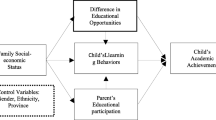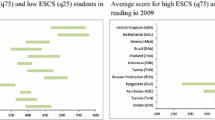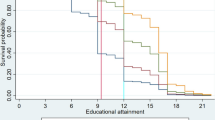Abstract
As the developed world has experienced a shift away from the traditional two-biological parent family, scholars have sought to understand how children are faring in non-traditional homes. Debate has arisen over assertions that children from non-traditional families do less well in school. Concerns about selection issues as well as a paucity of cross-cultural evidence, have led some scholars to question the influence of family structure on educational attainment. Using data from the 2006 Uruguayan household survey, we evaluated the relationship of family structure with children’s education using two different methods to deal with selection problems, an instrumental variables approach and propensity score matching. Both approaches yield evidence that growing up in non-traditional family structures seems to be negative related with the schooling of Uruguayan boys, with more muted results for girls. Interestingly, Uruguay is a developing country with two peculiarities, that is, a culture that experienced fairly rapid modernization in terms of institutions—including family transition—especially compared with other South American nations, and meanwhile an intriguingly high level of school drop-out, unusually high for Uruguay’s overall level of development.



Similar content being viewed by others
Notes
We avoid using the controversial term “intact” to describe two-biological-parent homes (an unwieldy term!) and opt instead to use the somewhat less problematic “traditional.”
Academic year commences in March and no child may start primary school till he/she is 6 years old at least on April 30th.
This matching method was applied using the Stata ado file “psmatch2” developed by Leuven and Sianesi (2003).
References
Aguiar, S., Cabrera, M., & Filardo, V. (2009). Encuesta Nacional de Adolescencia y Juventud, Segundo Informe. Infamilia: Ministerio de Desarrollo Social.
Astone, N. M., Bishai, D., & Roche, K. M. (2007). Out-of-school care and youth problem behaviors in low-income, urban areas. Journal of Family and Economic Issues, 28, 471–488. doi:10.1007/s10834-007-9072-9.
Attanasio, O., & Székely, M. (2003). The family in flux. Inter-American Development Bank.
Berlinski, S., Galiani, S., & Manacorda, M. (2008). Giving children a better start: Preschool attendance and school-age profiles. Journal of Public Economics, 92, 1416–1440.
Brown, S. L. (2004). Family structure and child well-being: The significance of parental cohabitation. Journal of Family and Marriage, 66, 351–367.
Bucheli, M., Cabella, W., Peri, A., Piani, G., & Vigorito, A. (2002). Encuesta sobre Situaciones Familiares y Desempeños Sociales de las Mujeres. Facultad de Ciencias Sociales, Departamento de Economía, Documento de Trabajo 16/02.
Bucheli, M., & Vigna, A. (2005). Un estudio de los determinantes del divorcio de las mujeres de las generaciones 1947-56 y 1957-66 en Uruguay. Working Paper Department of Economics—dECON, Uruguay, 105
Cameron, A. C., & Trivedi, P. K. (2005). Microeconometrics. Methods and applications. Cambridge University Press.
Cid, A., & Ferrés, D. (2008). The coexistence of degree-premium and high-dropout rates in the Uruguayan secondary education: An incentives problem. Working Paper, Economics Department—Universidad de Montevideo. http://www.um.edu.uy/docs/thecoexistenceofdegree_cid_ferres.pdf. Accessed 31 March 2012.
Cid, A., Presno, I., & Viana, L. (2004). Institutions, Family and Economic Performance. Revista de Ciencias Empresariales y Economía. Universidad de Montevideo, 3.
Dew, J. (2009). The gendered meanings of assets for divorce. Journal of Family and Economic Issues, 30, 20–31. doi:10.1007/s10834-008-9138-3.
Díaz, R. (2003). Historia Económica del Uruguay. Montevideo, Taurus Eds.
Dribe, M., & Stanfors, M. (2009). Education, work and parenthood: Comparing the experience of young men and women in Sweden. Journal of Family and Economic Issues, 30, 32–42. doi:10.1007/s10834-008-9134-7.
Eldar-Avidan, D., Haj-Yahia, M. M., & Greenbaum, Ch W. (2008). Money matters: Young adults’ perception of the economic consequences of their parents’ divorce. Journal of Family and Economic Issues, 29, 74–85. doi:10.1007/s10834-007-9093-4.
Filgueira, C., Filgueira, F., & Fuentes, A. (2003). School attainment and transitions to adulthood in Latin America. In S. Duryea, A. Cox Edwards, & M. Ureta (Eds.), Critical decisions at a critical age: Adolescents and young adults in Latin America (pp. 179–218). Inter-American Development Bank.
Forry, N. D., Hofferth, S. L., & Peters, H. E. (2010). Child support, father–child contact, and preteens’ involvement with nonresidential fathers: Racial/ethnic differences. Journal of Family and Economic Issues, 31, 14–32. doi:10.1007/s10834-009-9172-9.
Frank, K., Frisco, M. L., & Muller, Ch. (2007). Parents’ union dissolution and adolescents’ school performance: Comparing methodological approaches. Journal of Marriage and Family, 69, 721–741.
Frisco, M. L., Raley, R. K., & Wildsmith, E. (2005). Maternal cohabitation and educational success. Sociology of Education, 78(2), 144–164.
Garasky, S., & Stewart, S. D. (2007). Evidence of the effectiveness of child support and visitation: Examining food insecurity among children with nonresident fathers. Journal of Family and Economic Issues, 28, 105–121. doi:10.1007/s10834-006-9049-0.
Gauthier, A. H., & Monna, B. (2008). A review of the literature on the social and economic determinants of parental time. Journal of Family and Economic Issues, 29, 634–653. doi:10.1007/s10834-008-9121-z.
Gennetian, L. A. (2005). One or two parents? Half or step siblings? The effect of family structure on young children’s achievement. Journal of Population Economics, 18, 415–436.
Giacometti, C. (2007). Las metas del Milenio y la igualdad de género. El caso de Uruguay. Mujer y Desarrollo (CEPAL), 88.
Ginther, D. K., & Pollak, R. A. (2004). Family structure and children’s educational outcomes: Blended families, stylized facts, and descriptive regressions. Demography, 41(4), 671–696.
Guigou, N. (2006). Religión y política en el Uruguay. Civitas—Revista de Ciências Sociais, 6(2), 43–54.
Hondroyiannis, G. (2010). Fertility determinants and economic uncertainty: An assessment using European panel data. Journal of Family and Economic Issues, 31, 33–50. doi:10.1007/s10834-009-9178-3.
INE. (2008). Indicadores Demográficos. Instituto Nacional de Estadística. Retrieved from http://www.ine.gub.uy.
INE. (2009). Encuesta Continua de Hogares. Instituto Nacional de Estadística. Retrieved from http://www.ine.gub.uy.
INE. (2010). Uruguay en Cifras. Serie Instituto Nacional de Estadística. Retrieved from http://www.ine.gub.uy.
Jalovaara, M. (2003). The joint effects of marriage partners’ socioeconomic positions on the risk of divorce. Demography, 40(1), 67–81.
Jeynes, W. H. (2002). Examining the effects of parental absence on the academic achievement of adolescents: The challenge of controlling for family income. Journal of Family and Economic Issues, 23(2), 189–210. doi:10.1023/A:1015790701554.
Kalmijn, M., & Uunk, W. (2007). Regional value differences in Europe and the social consequences of divorce: A test of the stigmatization hypothesis. Social Science Research, 36(2), 447–468.
Langenkamp, A. G. (2009). Following different pathways: Social integration, achievement, and the transition to high school. American Journal of Education, 116(1), 69–97.
Leuven, E., & Sianesi, B. (2003). PSMATCH2: Stata module to perform full Mahalanobis and propensity score matching, common support graphing, and covariate imbalance testing. Retrieved from http://www.ifs.org.uk.
Lundberg, S., & Pollak, R. A. (2007). The American family and family economics. Journal of Economic Perspectives, 21(2), 3–26.
Maiztegui, L. (2005). Orientales. Una Historia Política del Uruguay. De los Orígenes a 1865. Montevideo, Planeta Eds.
Manacorda, M. (2006). Grade failure, drop out and subsequent school outcomes: Quasi-experimental evidence from Uruguayan administrative data. Working Paper Centre for Economic Performance—London School of Economics and Political Science. Retrieved from http://www.carloalberto.org.
McLanahan, S. S. (1985). Family-structure and the reproduction of poverty. American Journal of Sociology, 90, 873–901.
McLanahan, S. S., & Sandefur, G. D. (1994). Growing up with a single parent: What hurts, what helps?. Cambridge, MA: Harvard University Press.
Observatorio de la Familia. (2010). Centro de Investigaciones Aplicadas, Universidad de Montevideo, Uruguay. Retrieved from http://www.um.edu.uy/centroinvestigacionesaplicadas.
Observatorio de la Familia. (2008). Centro de Investigaciones Aplicadas, Universidad de Montevideo, Uruguay. Retrieved from http://www.um.edu.uy/centroinvestigacionesaplicadas.
Pagano, J., Pérez, V., Rossi, M., & Vairo, D. (2009). ¿Los hombres son mejores líderes políticos que las mujeres?: un estudio comparado sobre los valores de género en Uruguay y Chile. Working Paper No. 06/09. Retrieved from: http://www.fcs.edu.uy.
Paredes, M. (2003). Trayectorias Reproductivas, Relaciones de Género y Dinámicas Familiares en Uruguay. Doctoral Thesis, Universidad Autónoma de Barcelona. Retrieved from http://www.tdx.cat.
Peri, A. (2003). Dimensiones ideológicas del cambio familiar. In UNICEF-UDELAR (Eds.), Nuevas formas de familia. Perspectivas nacionales e internacionales (pp. 141–161). Montevideo: Tradinco Press.
Popenoe, D. (1993). American family decline, 1960–1990: A review and appraisal. Journal of Marriage and Family, 55, 527–542.
Pradere, G., & Salvador, S. (2009). Análisis de las trayectorias familiares y laborales desde una perspectiva de género y generaciones. Project “Apoyo a las políticas públicas para la reducción de las inequidades de género y generaciones G/INE/UNIFEM/UNFPA”. Retrieved from http://www.ine.gub.uy.
Ravela, P. (2005). A formative approach to national assessments: The case of Uruguay. Prospects, 35(1), 21–43.
Sax, L. (2006). What teachers need to know about the emerging science of sex differences. Educational Horizons, 84, 190–212.
Schramm, D. G. (2006). Individual and social costs of divorce in Utah. Journal of Family and Economic Issues, 27(1), 133–151. doi:10.1007/s10834-005-9005-4.
Stacey, J. (1993). Good riddance to “The Family”: A response to David Popenoe. Journal of Marriage and Family, 55, 545–547.
Thornton, A. (1985). Changing attitudes toward separation and divorce: Causes and consequences. The American Journal of Sociology, 90(4), 856–872.
UNESCO. (2010). Panorama Educativo 2010: Desafíos Pendientes. UNESCO Publications. Retrieved from http://www.unesco.org.
Wilcox, W. B., & Wolfinger, N. H. (2007). Then comes marriage? Religion, race, and marriage in urban America. Social Science Research, 36(2), 569–589.
Author information
Authors and Affiliations
Corresponding author
Rights and permissions
About this article
Cite this article
Cid, A., Stokes, C.E. Family Structure and Children’s Education Outcome: Evidence from Uruguay. J Fam Econ Iss 34, 185–199 (2013). https://doi.org/10.1007/s10834-012-9326-z
Published:
Issue Date:
DOI: https://doi.org/10.1007/s10834-012-9326-z




